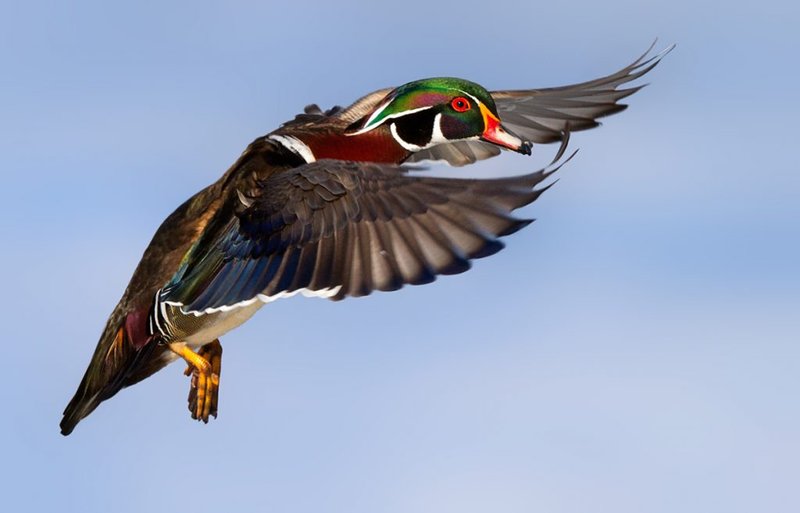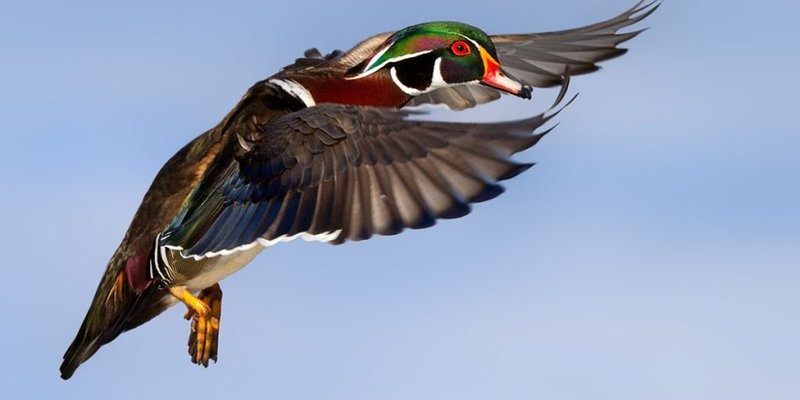
Wood ducks are the colorful gems of North American waterfowl, sporting iridescent feathers and striking patterns. But beyond their beauty, they possess unique skills that help them thrive in the wild. Their ability to fly swiftly and their clever hunting methods play a crucial role in their survival. So, if you’re curious about what makes these birds so remarkable, let’s dive into their flying and hunting techniques in detail.
Flight Patterns of the Wood Duck
When it comes to flying, the wood duck has some intriguing characteristics. They are known for their powerful flight and impressive speed. Unlike some birds that glide slowly, wood ducks prefer rapid wing beats. This lets them zip away from predators or take off quickly when they feel threatened.
Wood ducks often fly in a direct line, which is a bit different from other waterfowl that might fly in larger formations. When you spot a group of wood ducks flying, it can feel like watching a lively dance as they dart and weave through trees and branches. Their swift, agile flight is a key part of how they evade danger in their wooded, wetland homes.
You might be wondering, “How do they manage to change direction so quickly?” Well, their body structure plays a significant role here. With a compact body and strong wings, they can turn on a dime. This skill is crucial when they’re navigating through dense vegetation or trying to escape from predators, like hawks or raccoons.
Hunting Strategies of the Wood Duck
Now, let’s talk about how wood ducks hunt for food. These birds are omnivorous, which means they enjoy a varied diet. They primarily feast on seeds, fruits, and aquatic plants. Imagine a buffet of delicious treats spread out in their natural habitat! Their hunting techniques reflect this varied diet.
Wood ducks often forage in shallow waters, using their unique abilities to find food. They tip their bodies upside down, called “dabbing,” which allows them to reach underwater plants and insects. This not only helps them find food but also lets them stay hidden from any potential threats nearby. It’s like having a lunch break while keeping an eye out for trouble!
Interestingly, wood ducks are also known to feed on land when they need to. They have strong legs that allow them to walk around on grassy areas, pecking at seeds and berries. This flexibility in their hunting habits helps them adapt to different environments—whether they’re in a marsh, river, or forested area.
Adaptations for Survival
One of the amazing things about wood ducks is their adaptations for survival. These features help them thrive in various environments while also staying safe from predators. A perfect example is their camouflage. With their vibrant plumage, you might think they’d stick out like a sore thumb. But the intricate patterns and colors help them blend seamlessly into their leafy surroundings.
Moreover, wood ducks are excellent at perching in trees. They often nest in tree cavities, which keeps them off the ground and safe from many land-based predators. This nesting behavior is quite unique for ducks, who usually prefer to create nests on the ground. It’s like having a cozy treehouse that’s hard to reach!
Their adaptability doesn’t stop there. Wood ducks also have the ability to fly at varying heights depending on the landscape they’re navigating. This can help them avoid obstacles and predators. Honestly, it’s a testament to how well they can thrive in environments that might seem challenging to other birds.
The Importance of Their Habitat
Wood ducks thrive in habitats that provide both water and ample tree cover. They prefer wooded swamps, marshes, and ponds, where there are plenty of places for them to forage and hide. You might be surprised to learn that the health of wood ducks is closely tied to the health of their habitats.
When their environment is threatened—by pollution, development, or climate change—it can directly affect their food sources and nesting sites. This is why preserving wetlands and wooded areas is crucial. It’s like taking care of your favorite garden; if the plants aren’t healthy, the whole ecosystem suffers.
Efforts are being made to protect these habitats and ensure that wood ducks can continue to flourish. Habitat restoration, alongside conservation efforts, helps maintain the delicate balance that supports these stunning birds.
Challenges Faced by Wood Ducks
Despite their remarkable adaptations and skills, wood ducks face several challenges in the wild. One of the biggest threats comes from habitat loss. As more wetlands and forests are developed or drained, these birds have fewer safe places to live and feed. It’s akin to losing your favorite hangout spot, and it can make things tough.
Predation is another concern. Young wood ducks, in particular, are vulnerable to various predators on land and in the air. This means that every nesting season is a critical time for them, where their survival hinges on escaping the watchful eyes of predators.
Additionally, climate change poses threats to the habitats that wood ducks rely on. Changes in rainfall patterns or temperature can affect the availability of food and nesting sites. This ongoing issue is something that conservationists are keenly aware of and actively working to combat.
The wood duck is more than just a pretty face in the bird world. With its unique flying and hunting techniques, it showcases an impressive blend of adaptability, beauty, and resilience. From their rapid flight patterns to their clever foraging methods, these birds have found ways to survive and thrive in their environments.
Understanding the challenges that wood ducks face helps us appreciate the importance of protecting their habitats. Each time we see one of these colorful birds soaring through the trees, it’s a reminder of the need for conservation efforts. So, the next time you spot a wood duck, take a moment to enjoy its beauty and reflect on the remarkable skills that help it navigate the world.

